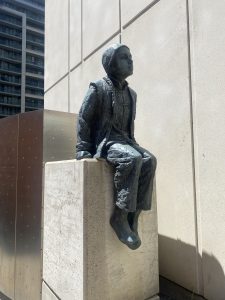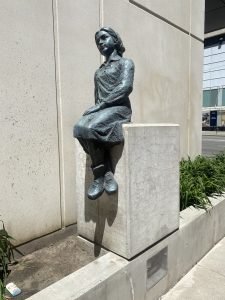Across Time and Space, Two Children of Toronto Meet (2013)
by Kaliyah Macaraig

Nestled within the quiet Bay street corridor, away from the bustling urban activity of the city you can find two bronze sculptures of children sitting on concrete plinths looking across at one another—immigrant youth of the past. The profound juxtaposition of Canada’s settler history and the physical, lifelike presence of this work calls us to ask: who are these children and why are they here? The physical and sensorial experience of viewing the sculpture is a gateway to investigate uniting and competing conceptions of Canadian histories, Canadian identity, and the formation of communities within urban spaces.

Breaking boundaries
Ken Lum’s Across Time and Space, Two Children of Toronto Meet is situated in a walkway space leading off of Bay Street, just west of the Eaton Centre and north of City Hall. The corridor space is created by a looming condo on one side and a brick wall on the other, rendering this transitory area as visually inaccessible unless physically entered.

In contrast to the concrete blocks on which they perch, the two bronze children are naturalistically rendered. The boy wears traditional Chinese clothing, closely related to the clothing worn during the Qing dynasty including the six paneled “Little Hat,” and the tunic with a mandarin collar and frog buttons which were popular during this period.[1] The girl wears a simple collared, long sleeve dress with a bandana tying her hair. These figures are placed against the northern wall of the corridor, sitting and facing one another on elevated stone pillars, several metres apart. The children lean on their arms and cross their legs, indicating comfort but their engaged muscles demonstrate a lingering sense of tension. A glimmer of anticipation is further evinced through their contemplative gazes into the distance, as if the children are waiting or even searching for something. A bordered and elevated area of greenery stretches between the bases of the stone pillars to subtly demarcate the space between the children as part of the artwork, and the sidewalk as the venue of the viewer.
Lum dissolves the barrier between art and life as he brings his created work to the urban space of the city, placing the artwork in a liminal area where everyday, constant interaction takes place. The highly public location of the work and its striking lifelike qualities, naturalism, and out-of-the-box placement creates opportunities for contemplation among a wider audience. The physical and social immersion of the children is essential to Lum’s call to contemplate upon humanity and identity.
The words on the wall between the two figures reads, “Across time and space, two children of Toronto meet…” The work calls the audience to think about the children’s divergent histories which have preceded their settling in Toronto. Specifically, the figure of the boy in traditional clothing is symbolic of the Chinese immigrant community through his cultural clothing. In contrast, the figure of the little girl in European dress, becomes a pivotal reminder of Canada’s white immigrant history, which has interacted directly with the Chinese immigrant history in the nation. The poignant decision to depict children, thought of as innocent and unburdened by race and class, prompts the audience to reflect on the intricacies of immigrant histories through the lens of these voiceless youth, thinking about how lives were affected and questions of agency in settling. By facing the children toward one another, Lum uses his art to point towards a complicated web of national settler histories that converge and negotiate with one another, which has taken place in this very area of the downtown core.
Toronto’s Chinese community flourished in various pockets of the city since the late 1800s, but the major displacements that occurred over the early years of the twentieth century are often forgotten. In 1904, a fire destroyed the original Chinatown, resulting in the community’s relocation to the Ward neighbourhood stretching from College Street to Queen Street and Yonge Street to University Avenue. Soon after, from the 1920s to 1960s, Chinatown was demolished and the land expropriated to build the Eaton Centre and City Hall. Decades after the displacement, Lum’s work stands in the Ward as a physical reminder of the neglected Chinese community that was excluded from the creation of a representative urban space those years ago. Lum also remembers the European immigrant community that lived in the Ward through the figure of the little girl, once again pointing toward the intersecting settler histories of this area, largely characterized by economic hardship and villification by the wider public.
Art as exploration and commemoration
In much of his work, Lum frequently interrogates his own identity, exploring intersections of Chinese identity and Canadian and American identities. His photography, often billboard-scaled, and sculptures of varying materials address contemporary life, culture, and identity.
Raised by his Chinese mother who immigrated to British Columbia his sense of Chinese identity and middle class upbringing often influences his art and writings as he notes: “All my work really is a kind of theory of my upbringing in Canada.”[2] Art becomes a medium of investigation into identity and community for Lum, and his bold and clever works are crafted as opportunities for the public to take on the same investigative stances. The elevation of marginalized and underserved communities through art is a closely related focus for Lum. He spearheads the Monument Lab in Philadelphia, a project focused on promoting public art in the city by conversing with particular communities to determine which people and which values are to be memorialized through public works. This deliberate and conscious approach to creating public art is increasingly employed by local governments who use these works to promote a sense of unity by celebrating all communities, especially those that have been socially and systematically overlooked
Public art: Building community through visuality and spatiality
Lum’s Two Children of Toronto created in 2013 anticipated an extensive public art initiative several years later, in the same vein as the Monument Lab project, with the unveiling of Toronto’s new 10 year public art strategy. The plan’s aim was to fund public art, especially in underserved communities, to create diverse advisory committees, to protect the public art of the city, and to fund and promote opportunities for Indigenous artists to create public works. Civic engagement is a continual focus for this strategy, emphasizing art’s ability to unite Toronto as a single community: “advance broader city-building priorities, such as equity and inclusion, environmental resiliency, reconciliation with Indigenous communities, and placemaking, among others.”[3] Examining the plan, it is clear that public art is positioned as a means by which specific identities and communities can be celebrated by the larger community through a visually and physically communicative form. Spaces like parks, downtown corners, and waterfronts which house different networks of interaction within communities are prime locations for these artworks to ideally engage with the public, provoke dialogue, and afford a space of belonging for a community through their representative piece. This is essential to the strategy’s ultimate goal of equity and inclusion.
Public art and the new strategy in Toronto has a complex relationship with the multiple identities present here. The city’s funding of multiple different communities demonstrates the heterogeneity of the denizens of Toronto, each having different symbols and icons that resonate with them, different geographic pockets of the city, and different histories. On the other hand, the strategy pushes the idea that a totalizing Torontonian identity exists, or can be further crystallised, through artwork’s ability to unite based on shared values. Public art has the ability to engage with multiple identities at once, whether within or across communities because of its integration into the lived space. Ultimately, an individual’s own experiences and identity determines the level of belonging afforded by a public work.
Negotiating identity
Ken Lum’s work explores multiple competing identities within Toronto or the nation at large, with a focus on immigrant and Chinese identities. Across Time and Space, Two Children of Toronto recenters people and communities that have been at the margins of Canada or Toronto as a relational identity by literally placing these identities in highly public space. His work employs physical markers of identity to crystallize and question complex, social frameworks of identity. Lum’s art expertly balances the conversations around identity by exploring specific communities and ways of life whilst also being provocative and compelling works that draw all viewers into contemplative modes of thought. These tensions between competing and united identities will continue to be a conversation for artists, governments and communities to engage in.
About the author
Kaliyah Macaraig is a student at the University of Toronto. She completed an internship with Open Art Histories in the summer of 2022.
Further reading
Bingham-Hall, John. “Public Art as a Function of Urbanism.” In The Everyday Practice of Public Art, edited by Cameron Cartiere and Martin Zebracki, 161-76. London and New York: Routledge, 2016.
Bhabha, Homi K. Introduction to Nation and Narration. London and New York: Routledge, 1990.
City of Toronto. Toronto Public Art Strategy 2020/2030. December 2019, https://www.toronto.ca/wp-content/uploads/2019/12/92e1-Toronto-Public-Art-Strategy-2020-2030.pdf.
Deckel, Johnathan. “‘This is going to change the look and feel of the city’: Mayor John Tory on Toronto’s Year of Public Art and His Plan to Keep Artists from Decamping.” Toronto Star (Toronto, ON), October 30, 2021. https://www.thestar.com/entertainment/visualarts/2021/10/30/this-is-going-to-change-the-look-and-feel-of-the-city-mayor-john-tory-on-torontos-year-of-public-art-and-his-plan-to-keep-artists-from-decamping.html.
Egan, Danielle. “Ken Lum Road to Somewhere.” Canadian Art, April 2019. https://canadianart.ca/features/ken-lum-road-to-somewhere/.
Lum, Ken. Interview by Sean O’Neill. In the Making, CBC Gem, October 20, 2019.
Lum, Ken. “Some Reflections on Urban Public Art Today, 2014.” In Everything is Relevant: Writings on Art and Life, 1991-2018. Philadelphia: Penn Institute for Urban Research, 2014.
Mannie, Kathryn. “The Rise and Fall of Chinatown, the Hidden History of Displacement You Were Never Told.” Global News (Toronto, ON), May 26, 2022. https://globalnews.ca/news/8793341/chinatown-history-toronto-vancouver-montreal-canada/.
Palmer, Joni. “Why Public Art? Urban Parks and Public Art in the Twenty-First Century.” In The Everyday Practice of Public Art, edited by Cameron Cartiere and Martin Zebracki, 208-22. London and New York: Routledge, 2016.
Plummer, Kevin. “Historicist: Forgotten Urban Squalor of the Ward.” Torontoist (Toronto, ON), October 11, 2008.
Yang, Shaorong. Traditional Chinese Clothing: Costumes, Adornment and Culture. San Francisco: Long River Press, 2004.
- Shaorong Yang, Traditional Chinese Clothing: Costumes, Adornment and Culture (San Francisco: Long River Press, 2004), 13. ↵
- Ken Lum, Interview by Sean O’Neill, In the Making, CBC Gem, October 20, 2019. ↵
- City of Toronto, Toronto Public Art Strategy 2020/2030, December 2019, p. 9, https://www.toronto.ca/wp-content/uploads/2019/12/92e1-Toronto-Public-Art-Strategy-2020-2030.pdf. ↵

